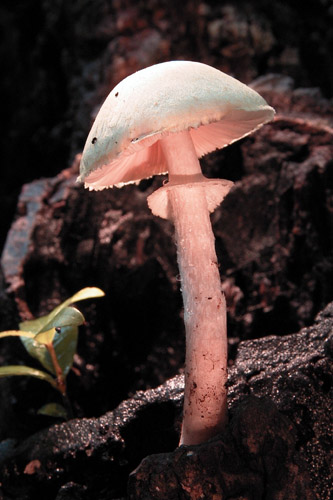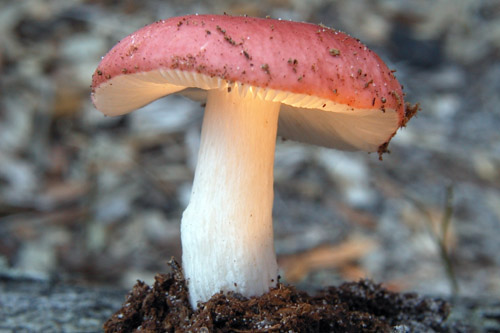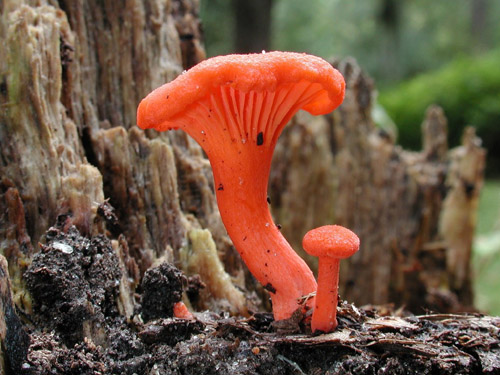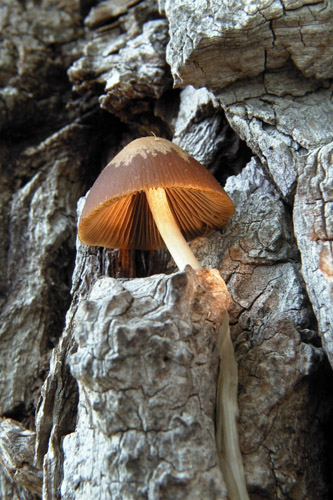The Secret World
©Mark Hilliard (2000)
|
| |
|
Nature surrounds us, from the dark rain forests of the Amazon to the
potted plant on the kitchen sink. All you have to do is look. This article
is not about unlikely locations but rather about unlikely subjects!
|
|
|
|
They are everywhere, out in plain sight but unseen, under every tree,
in the mulch and if you take a stroll through the woods you will step
on more than you actually see. The mighty trees we see around us everyday
of our life would not be mighty without them. Have you ever stopped
and looked at one, really looked at it? You know what I am talking about
… right? Of course, the innocuous mushroom! Is it a plant or an animal?
Neither, it is in a world of its own, a fifth kingdom if you will, one
filled with such awe-inspiring beauty that it will take your breath
away. Keep reading and you will be forever hooked on this fascinatingly
beautiful unseen side of nature.
|
|
|
|

Amanita citrina
|
|
|
|
Take a look at this first photograph of a common Amanita citrina mushroom
found growing from the ground up through a rotting stump in Myrtle Beach,
SC. The mushroom itself is only about 2 inches high and on the inside
of a hollow stump. From our normal vantage point all we would see of
this is a white cap. But when you actually get down on its level a whole
new magical world opens up to us.
|
|
|
|
As photographers trying to capture the beauty of these little wonders,
a new world of hardships is thrust upon us because we are now in the
world of macro photography. To take the thought one step further, lets
discuss this type of photography using todays new DIGITAL cameras! There
are three areas of difficulty in mushroom photography that must be overcome
in order to achieve good photographs, focus/depth of field, lighting/stability
and the ability to see what you are looking at in such low positions.
|
|
|
|
FOCUS AND DEPTH OF FIELD CONTROL
The first and formost hardship when photographing in the macro world
is focus and depth of field. Most digital cameras offer a macro mode
of some sort, the camera used for this photograph has a minimum focus
distance of around 8 inches which is decreased by the addition of a
+4 diopter closeup lens. This lens is simply a screw on adapter that
attaches to the front of the camera via the filter attachment threads,
and it reduces the minimum focus distance to about 4 inches. This is
generally close enough to allow the capture of most small mushrooms
that you might come across. Most digital cameras on the market offer
a macro mode, some have filter threads. Keep in mind that as we decrease
the minimum focus distance we also decrease the depth of field, which
brings us to the second major hurdle. To keep mushroom in sharp focus,
you have to focus on the closest edge of the cap next to the camera,
so to keep the depth of field wide enough to allow a sharp photograph
we must shoot at the smallest aperture and for most digital cameras
this is around f8. So right off the bat we see that our choice of a
digital camera for macro photography must have the ability to at least
have an aperture priority control. Always use the smallest aperture
that your camera can support.
|
|
|
|

Russula pulchra
|
|
|
|
LIGHTING AND TRIPODS
Due to the small aperture, lighting becomes an issue so a sturdy tripod
is a must. At these close distances a strobe is usually out of the question,
it would burn out the photograph totally. Some companies offer controllable
ring strobes that attach to the front of the camera lens, but only a
few of the consumer/prosumer digital cameras on the market have the
built in intelligence to control this type of strobe. I prefer to shoot
in total shadow so that I can totally control the lighting and contrasts.
In the first photograph I used two small flashlights with ultra white
Xenon bulbs. One was used to highlight the top of the mushroom and the
second provided highlights from the bottom right. As you can see, it
provided a nice exposure and a pleasing photograph. The same technique
was used in this second photograph of a Russula pulchra mushroom found
in Murrells Inlet, SC. Again the mushroom was put in as much shade that
I could provide then the Xenon lights were set for highlights and contrast
control. Since two lights are being used a means for holding them in
place must be found. Several camera companies sell goose neck clamps
that work well by attaching the lights directly to the tripod. All of
the exposures using this method of lighting are quite long, usually
1/30 to 1 /2 second so a very sturdy tripod is necessary. Now back to
the use of a strobe in macro digital work. The new Nikon 990 has a TTL
built in strobe that can be adjusted from -2ev to +2ev. This is a marvelous
tool for macro work. This next photograph shows a Cantharellus cinnabarinus
mushroom that was lit totally with the internal Nikon strobe set at
-2ev from a distance of 1 inch! The best tip on using a strobe for this
type of macro work is to just experiment with it. You can cover a portion
of the strobe with a white cloth to further reduce its light output.
|
|
|
|

Cantharellus cinnabarinus
|
|
|
|
A remote shutter release cable is also a must, but few current digital
cameras have this capability. If yours does not, then use the cameras
built in self timer instead.
|
|
|
|
LCD DISPLAY
One of the important considerations in macro mushroom photography is
the LCD display on the digital camera being used. Taking a photograph
at eye level is fine but if you are attempting it a ground level or
inside of a hollow log, the ease in which you can see the LCD becomes
very important. Look for a camera that has a rotating LCD or a portion
of the camera itself that rotates. There are several cameras on the
market that do this and all are good choices. If you can see the LCD
from above while taking ground level photographs you will enjoy the
session much more!
|
|
|
|

Psilocybe pelliculosa
|
|
|
|
EQUIPMENT USED
Nikon 990 Digital Camera full size TIFF mode
Canon Pro 70 Digital Camera full size TIFF mode
Canon 250D +4 diopter closeup lens
Canon remote shutter release
Benbo Trekker Tripod
Mag Lights with Xenon bulbs.
|
|
|
|
For further information you can contact Mark at CVFrayedKnot@cs.com
or go to his web
page
|
|
|
|
|



